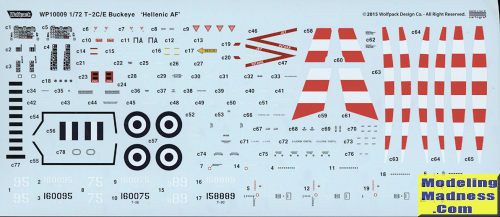
Wolfpack 1/72 T-2C/E Buckeye (Hellenic Air Force)
| KIT #: | WP 10009 |
| PRICE: | $@25.00 |
| DECALS: | One option plus two for the OS2Us |
| REVIEWER: | Scott Van Aken |
| NOTES: | 2016 boxing |

| HISTORY |
The first version of the aircraft entered service in 1959 as the T2J-1. It was re-designated the T-2A in 1962 under the joint aircraft designation system. The two-seat trainer was powered by one Westinghouse J34-WE-46/48 turbojet. The aircraft was subsequently redesigned, and the single engine was replaced with two Pratt & Whitney J60-P-6 turbojets in the T-2B. The T-2C was fitted with two much more powerful 2,950 lbf (13,100 N) thrust General Electric J85-GE-4 turbojets. The T-2D was an export version which was sold to the Venezuelan air force, while the T-2E was sold to the Greek Air Force. The T-2 Buckeye (along with the TF-9J) replaced the T2V-1/T-1A Seastar, though the T-1 would continue in some uses into the 1970s.
The Buckeye was designed as a low-cost multi-stage trainer. Its straight wing is similar to that used in the original North American FJ-1 Fury. Its cockpit controls are similar to the T-28C trainer. The T-2's performance is between that of the Air Force's T-37 Tweet, and the TA-4J Skyhawk. While it has no built-in armament, the T-2 has two underwing hardpoints for .50 in gun pods, 100 lb (45 kg) practice bombs or 2.75 in rockets.
All T-2 Buckeyes were manufactured by North American at Air Force Plant 85, located just south of Port Columbus Airport in Columbus, Ohio. 273 aircraft were built during its production run. The name Buckeye refers to the state tree of Ohio, as well as the mascot of the Ohio State University.
Virtually every Naval aviator from the late 1950's until 2004 received training in the T-2 Buckeye, a career spanning four decades. In the Naval Aviator syllabus, the T-2 has been replaced by the near-sonic T-45 Goshawk (the US Navy version of the BAE Hawk), which is more comparable to other high performance subsonic trainers, or the USAF T-38 Talon. More recently, the T-2 has been used as a director aircraft for aerial drones. Several T-2 Buckeyes are now registered in civilian markings and regularly appear at air shows.
| THE KIT |
![]()
The cockpit has two four part seats that fit into a tub with raised detail. Rudder pedals are molded onto the tub floor. The rear instrument panel fits into the rear anti-glare panel and the front one is not installed until near the end of the build. The nose gear well fits under the cockpit. A short tailpipe assembly fits in the back and you'll need 10 grams for the nose weight.
Typical of aircraft with low
fuselage mounted engines, there is a lower fuselage insert. Intakes are a single
piece and there is no long intake trunking. As mentioned, only the flaps are
separate and they can be posed up or lowered. Landing gear is very nicely done
and you can pose this with the gear doors closed for a stan d
model if you wish. There is a separate windscreen and canopy. The canopy can be
posed open. The kit includes a set of masks for the clear parts and for the
wheels, a very nice touch.
d
model if you wish. There is a separate windscreen and canopy. The canopy can be
posed open. The kit includes a set of masks for the clear parts and for the
wheels, a very nice touch.
Instructions are quite well
done and provide color information with FS 595 or generic names whichever is
appropriate. I like that the actual color is provided in the color blocks. There
are also a number of nice photos of Greek planes to help with parts painting and
placement. All three options differ only by serial number and from the 2007-2009
time period. These planes are in the standard SEA colors used by the US during
the Vietnam War. Decals are very nicely done.
| CONCLUSIONS |
| REFERENCES |
Back to the Main Page Back to the Previews Index Page
Back to the Previews Index Page